Inside the Upstate Institute: New Director Selleck Settles In
Bruce Selleck began as Direc-tor of the Upstate Institute in July, though he has been involved with the Institute as a member of the Executive Board for the last 12 years.
“The way we envisioned this is that we exist to make connections between students and faculty who are engaged in research and that can take place in the context of classes, like upper level classes and indepen-dent studies, also summer research or faculty research,” Selleck said.
The Upstate Institute has been in place at Colgate for years, benefitting both the Col-gate Campus and the surround-ing community. Students and professors interact directly with people, organizations and gov-ernments in central New York, working together to come up with solutions to problems or provide insights that will help the community.
The Institute works primarily with projects in Madison County, Chenango County, Utica and the Adirondacks, though Madison County is, geographically, the central focus.
The program exists mainly for juniors and seniors who have the skill-sets and experience necessary to perform these services to the community. The program works through the summer field school, which supports about 20 under-graduate students each summer. The students work for organizations such as local not for profits, governments, social service departments, county planning agencies, Utica’s refugee center and various food cupboards. The students work to make those entities more self-sustaining and improve the quality of services they deliver to their communities, which can involve grant writing, data collection and analysis.Some confuse the Upstate Institute with Colgate’s Center for Outreach, Volunteerism and Education (COVE). Selleck sees the Up-state Institute as a provider of necessary services that improve the community in infrastructural rather than social ways.
“It is really to find connections and synergy that is more than just volunteer work. We have faculty who have done research projects on things from changes in maple syrup chemistry to invasive species to the spirit house in George-town. The notion is that the research students and faculty do can be useful to the immediate community and sometimes the communities and organizations in the region have needs that can be met by research that students and faculty might undertake,” Selleck said.
There is a campus-based Executive Board for the Institute, as well as a Community Board. The two groups communicate based on the needs of the community that correspond to students’ and professors’ ideas, collaborating to find the best ways to make improvements.
Senior Emmalee Dolfi spent her summer working as a field school fellow for the Up-state Institute. She took the Greenhouse Gas Inventory for the Village and Town of Ham-ilton, which included studying and organiz-ing fuel consumption used by the buildings and facilities owned by the town. During this time she worked closely with the Village Ad-ministrator, the Hamilton Police Chief and the Village Mayor Margaret Miller. Her re-search allowed her to make educated conclu-sions and recommendations to the town of Hamilton regarding their carbon emissions.
“The most worthwhile aspect of working for the Upstate Institute is the knowledge I have gained about the local community. I have a much deeper appreciation for Ham-ilton and try my best to support the local businesses and get to know fellow residents not associated with Colgate,” Dolfi said.
Selleck expressed the importance of synergy within these projects, noting that the interactions between the university and the community benefit both entities in the process.
“We envision the community of scholars that is the campus, student and faculty have capacity that can be useful to the local commu-nity, there are problems and issues and topics of research in the local community that are of in-terest to students and faculty,” Selleck said. “We try to build that synergy at a very high level.”
Contact Caroline Main at [email protected].



